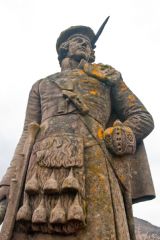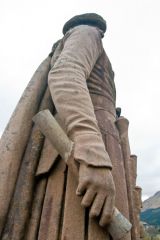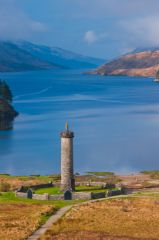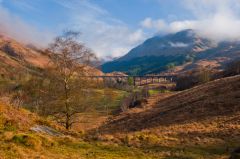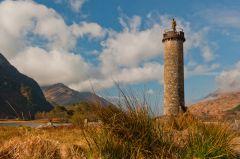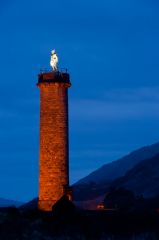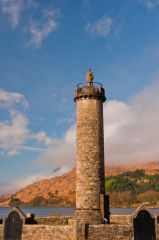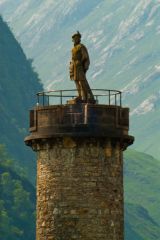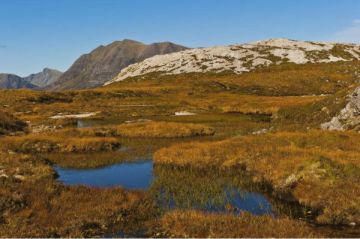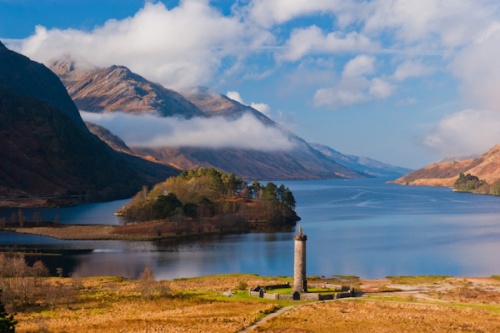
If there is a more beautifully situated monument in Britain than the Glenfinnan Monument, I have yet to see it. This striking stone tower stands in isolated splendour on the shore of Loch Shiel, close to the spot where Bonnie Prince Charlie raised his standard on 19 August 1745.
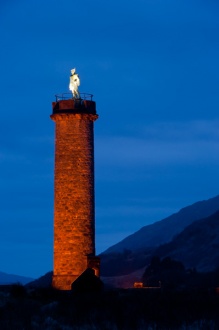
Prince Charles Edward Stuart was the son of James VIII of Scotland and II of England. He had been brought up in exile, but raised with the firm belief that his father deserved to be the rightful king of England and Scotland. He also believed, wrongly as it turned out, that huge numbers of English and Scots were ready to support his father's cause.
The Prince set sail from France in a hired ship, the De Tallay, and landed at Eriskay. From there he sailed to Loch nan Uamh, about 15 miles west of Glenfinnan. He anticipated a large welcome from the Highland clans, but was disappointed by the low numbers of supporters ready to welcome him. However, the grand moment was yet to come.
Word was sent to Jacobite supporters across the Highlands and in Edinburgh that the Prince had arrived. Supporters were called to Glenfinnan for the raising of the Stuart standard. The act of raising a standard was a symbolic one; it had no real significance except that it gave notice to the Prince's supporters and his enemies that he officially claimed the throne for his father, and called on all who supported him to join his army.
Accounts of the day are somewhat difficult to unravel. Almost certainly the standard was not raised where the monument now stands; more likely a small hill nearby was used, possibly the same hill that now offers a viewing platform for the monument and the viaduct further up the glen.
As for the monument itself, it was built in 1815 by Alexander Macdonald of Glenaladale, a local landowner, whose father's cousin was the chief with whom the prince stayed the night before the standard was raised.
Macdonald himself died the same year the Monument was built, after a life given to pleasurable pursuits and too much drinking. Much of his life seems to have been given over to the grand, theatrical gesture - much like the prince he sought to commemorate.
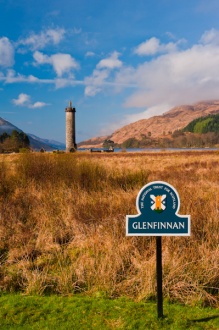
Macdonald hired James Gillespie Graham, one of the leading architects of early 19th-century Scotland, to design a classically inspired column with Tudor Gothic decorative elements. Macdonald family tradition says that Graham used William Miller of Fort William as his master mason for the job.
The column is entered by a porticoed doorway in the base, which gives onto an internal spiral stair. The stair leads to a platform surmounted by a huge statue of a man in Highland dress. Though the statue may represent Bonnie Prince Charlie, it may equally be meant to represent a generic Highland chief. Interestingly, the monument did not initially have a statue on top; that was added during a second phase of work in the 1830s. It was designed by sculptor John Greenshields.
The base of the statue is surrounded by a low stone wall, into which are set plaques detailing the purpose of the monument in three languages; Latin, Gaelic, and English.
Though you can climb the monument and look out over Loch Shiel from the top, by far the best way to get the full impact of the Glenfinnan Monument is to climb the low hill behind the visitor centre. This hill, which may be the very one where the prince's standard was raised, gives you wonderful views over the loch and the monument below, and up the glen to the viaduct.
Our Verdict
One of Scotland's truly iconic sights; come in the early morning and see the mist rolling across the head of the loch, shrouding the memorial on its slender column.
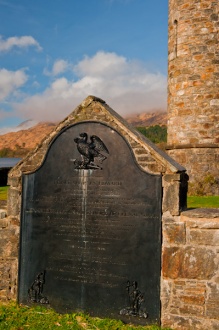
Charlie memorial
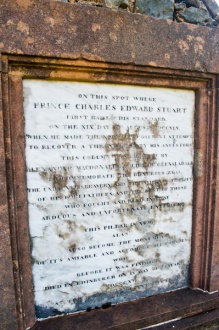
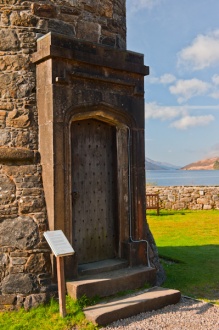
Glen Shiel beyond
About Glenfinnan Monument
Address: NTS Information Centre,
Glenfinnan,
Lochaber,
Highlands ,
Highland,
Scotland, PH37 4LT
Attraction Type: Historic Building - Monument
Location: On the A830, 18 miles (30 km) west of Fort William
Website: Glenfinnan Monument
Email: glenfinnan@nts.org.uk
National Trust for Scotland
Location
map
OS: NM901808
Photo Credit: David Ross and Britain Express
HERITAGE
 We've 'tagged' this attraction information to help you find related historic attractions and learn more about major time periods mentioned.
We've 'tagged' this attraction information to help you find related historic attractions and learn more about major time periods mentioned.
Historic Time Periods:
Find other attractions tagged with:
19th century (Time Period) - Bonnie Prince Charlie (Person) - Jacobite (Historical Reference) - James II (Person) - Stuart (Time Period) - Tudor (Time Period) -
NEARBY HISTORIC ATTRACTIONS
Heritage Rated from 1- 5 (low to exceptional) on historic interest
Glenfinnan Viaduct - 0 miles (Countryside) ![]()
Prince's Cairn, Loch nan Uamh - 11.4 miles (Countryside) ![]()
Prince's Walk, Kinlochmoidart - 12.8 miles (Countryside) ![]()
West Highland Museum - 13.2 miles (Museum) ![]()
Road to the Isles - 13.2 miles (Countryside) ![]()
Neptune's Staircase - 13.5 miles (Landmark) ![]()
Old Inverlochy Castle - 14 miles (Castle) ![]()
Castle Tioram - 15.5 miles (Castle) ![]()
Nearest Holiday Cottages to Glenfinnan Monument:
Nearby accommodation is calculated 'as the crow flies' from Glenfinnan Monument. 'Nearest' may involve a long drive up and down glens or, if you are near the coast, may include a ferry ride! Please check the property map to make sure the location is right for you.
Glenfinnan, Highlands and Islands
Sleeps: 4
Stay from: £597 - 2932
Glenfinnan, Highlands and Islands
Sleeps: 6
Stay from: £634 - 3089
Blaich, Highlands and Islands
Sleeps: 4
Stay from: £368 - 2055
More self catering near Glenfinnan Monument
